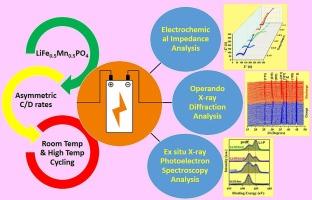锂化/衰减速率对LiFe0.5Mn0.5PO4/Fe0.5Mn0.5PO4界面的影响:通过结构、表面化学和阻抗进行跟踪
IF 4.6
3区 材料科学
Q2 MATERIALS SCIENCE, MULTIDISCIPLINARY
引用次数: 0
摘要
LiFe0.5Mn0.5PO4 (LFMP)可以结合LiFePO4和LiMnPO4的优点,提供更高的能量密度、循环寿命和良好的热稳定性,被认为是一种很有前途的阴极。在这项工作中,我们报告了利用微波辅助溶剂热工艺和随后的碳涂层制备的LFMP阴极的电化学性能。除材料综合分析外,还进行了电化学分析;最佳样品在25 mA/g电流密度下的放电容量为134 mAh/g,在300 mA/g电流密度下的放电容量为112 mAh/g。为了了解对电池性能有重要影响的锂化速率或衰减速率,研究了25 ~ 300 mA/g的不对称充放电速率。研究结果表明,快速充电和实际放电速率的不对称条件适合LFMP在保留高锰氧化还原电压的同时,对容量有一定的影响。利用operando- x射线衍射研究了在第一次充放电循环中发生的结构变化。同时,对不同充放电速率下的材料进行了阻抗分析、非原位XRD和表面化学研究。进行了两种不同的高温循环试验,以确定其与室温性能的相关性。本文章由计算机程序翻译,如有差异,请以英文原文为准。

Effect of lithiation/delithiation rate on the interface of LiFe0.5Mn0.5PO4/Fe0.5Mn0.5PO4: Tracking through structure, surface chemistry and impedance
LiFe0.5Mn0.5PO4 (LFMP) is regarded as a promising cathode that can combine the advantages of LiFePO4 and LiMnPO4, providing higher energy density, cycle life and good thermal stability. In this work, we report the electrochemical performance of LFMP cathode prepared using a microwave-assisted solvothermal process and subsequent carbon coating. Apart from comprehensive materials analysis, the electrochemical analysis has been conducted; the best sample delivered a discharge capacity of 134 mAh/g at 25 mA/g and 112 mAh/g at a higher current density of 300 mA/g. To understand the lithiation rate or delithiation rate, which plays a major impact on the performance, asymmetric charge–discharge rates between 25 and 300 mA/g were investigated. It is realized that the asymmetric condition of fast charging and practical discharge rate is suitable for LFMP to retain the benefit of higher Mn-redox voltage, in spite of a slight compromise on the capacity. The operando-X-ray diffraction studies were conducted to examine structural changes that occur during 1st charge/discharge cycle. Also, impedance analysis, ex situ XRD and surface chemical studies with different charge/discharge rates have been investigated and correlated. Two different high-temperature cycling tests were carried out for a correlation with the room temperature performance.
求助全文
通过发布文献求助,成功后即可免费获取论文全文。
去求助
来源期刊

Materials Science and Engineering: B
工程技术-材料科学:综合
CiteScore
5.60
自引率
2.80%
发文量
481
审稿时长
3.5 months
期刊介绍:
The journal provides an international medium for the publication of theoretical and experimental studies and reviews related to the electronic, electrochemical, ionic, magnetic, optical, and biosensing properties of solid state materials in bulk, thin film and particulate forms. Papers dealing with synthesis, processing, characterization, structure, physical properties and computational aspects of nano-crystalline, crystalline, amorphous and glassy forms of ceramics, semiconductors, layered insertion compounds, low-dimensional compounds and systems, fast-ion conductors, polymers and dielectrics are viewed as suitable for publication. Articles focused on nano-structured aspects of these advanced solid-state materials will also be considered suitable.
 求助内容:
求助内容: 应助结果提醒方式:
应助结果提醒方式:


